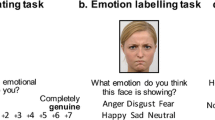Abstract
This study examined three- to seven-year-old children's abilities to recognize and label their own facial expressions of emotion. Each child posed four facial expressions (Happy, Sad, Angry, and Scared) which were photographed with a Polaroid camera. The child then selected each expression from the array of his/her own photos and labeled the facial expression of each photo. In addition to children's self-evaluations, the photo set's expressive content was evaluated by a panel of adult raters. Happy was the expression easiest for children to pose; Scared was the most difficult. Abilities involved in evaluating one's own facial expression (i.e., recognizing and labeling) appear not to be acquired simultaneously with the ability to pose the expression. Not all children conformed to adult standards in evaluating their own expressions. Nearly one-fifth of the children studied exhibited evidence of an idiosyncratic expressive scheme for at least one of their facial expressions.
Similar content being viewed by others
References
Abramovitch, R. Children's recognition of situational aspects of facial expression.Child Development, 1977.48, 459–463.
Barden, R. C., Zelko, F. A., Duncan, S. W., & Masters, J. C. Children's consensual knowledge about the experiental determinants of emotion.Journal of Personality and Social Psychology, 1980.39(5), 968–976.
Borke, H. Interpersonal perception of young children: Egocentrism or empathy?Developmental Psychology, 1971.5, 262–269.
Charlesworth, W. R. and Kreutzer, M. A. Facial expression of infants and children. In P. Ekman (Ed.)Darwin and Facial Expression: A century of research in review. New York: Academic Press, 1973.
Eiland, R. & Richardson, D. The influence of race, sex and age on judgements of emotion portrayed in photographs.Communication Monographs, 1976.43, 167–175.
Ekman, P. & Oster, H. Facial expressions of emotion.Annual Review of Psychology, 1979.30, 527–554.
Gates, G.S. An experimental study of the growth of social perception.Journal of Educational Psychology, 1923.14, 449–461.
Green, S. K. Causal attribution of emotion in kindergarten children.Developmental Psychology, 1977.13, 533–534.
Guthrie, P. T. & Smouse, A. D. Perception of emotions and attribution of acceptance by normal and emotionally disturbed children.Journal of Nonverbal Behavior, 1981.5(4), 253–263.
Hamilton, M. L. Imitative behavior and expressive ability in facial expression of emotion.Developmental Psychology, 1973.8, 138.
Honkavaara, S. The psychology of expression.British Journal of Psychology Monograph Supplements, 1961.32, 1–96.
Mayo, C. & France, M. On the acquisition of nonverbal communication: A review.Merrill-Palmer Quarterly, 1978.24(4), 213–228.
Moyer, D. M. The development of children's ability to recognize and express facially posed emotion. (Doctoral dissertation, Ohio State University, 1974) (University Microfilms No. 75–11, 401).
Nolan, E. & Kagan, J. Recognition of self and self's products in preschool children.Journal of Genetic Psychology, 1980.137, 285–294.
Odom, R. D. & Lemond, L. C. Developmental differences in the perception and production of facial expressions.Child Development, 1972.43, 359–369.
Saarni, C. Cognitive and communicative features of emotional experience, or do you show what you think you feel? In M. Lewis & L. A. Rosenblum (Eds),The development of affect. New York: Plenum Press, 1978.
Vine, I. The role of facial-visual signalling in early social development in M. Von Cranach and I. Vine (Eds.),Social communication and movement. New York: Academic Press, 1973.
Zuckerman, M. and Przewuzman, S. J. Decoding and encoding facial expressions in preschool-age children.Environmental Psychology and Nonverbal Behavior, 1979.3, 147–163.
Author information
Authors and Affiliations
Rights and permissions
About this article
Cite this article
Shields, S.A., Padawer, J.A. Children's standards for judging their own facial expressions of emotion. J Nonverbal Behav 8, 109–125 (1983). https://doi.org/10.1007/BF00986998
Issue Date:
DOI: https://doi.org/10.1007/BF00986998




